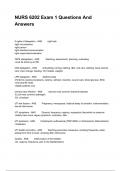NURS 6202 Exam 1 Questions And
Answers
5 rights of delegation - ANS right task
right circumstance
right person
right direction/communication
right supervision/evaluation
TAPE (delegation) - ANS -Teaching, assessment, planning, evaluating
-must be done by an RN
CNA delegation - ANS ambulating, turning, bathing, I&O, oral care, toileting, basic ostomy
care, linen change, feeding, VS if stable, weights
LPN delegation - ANS -Gathers Data
-Performs routine procedures: ostomy, catheter, insertion, wound care, blood glucose, EKG
-Oral and IM meds
-Stable patients only
Urinary tract infection - ANS -second most common bacterial disease
-E.coli most common pathogen
-Dx: urinalysis
UTI risk factors - ANS Pregnancy, menopause, habitual delay of urination, instrumentation,
sexual intercourse
UTI symptoms - ANS -Dysuria, frequency, urgency, suprapubic discomfort or pressure
-elderly have more vague symptoms- confusion, falls
UTI treatment - ANS trimethoprim-sulfonamide (TMP-SMX) or nitrofurantoin (Macrodantin)
*Antibiotics
UTI health promotion - ANS Teaching preventive measures- urinating frequently, water,
wiping from front to back, urinating after intercourse
Cystitis - ANS inflammation of the bladder
-Sx: urgency, frequency, pain in the bladder/pelvis
, - Stress management techniques, tricyclic antidepressants and OTCs help with burning pain
and urinary frequency; avoid clothing that creates suprapubic pressure
Urethritis - ANS -inflammation of the urethra
-most commonly from an STI
-Sx: discharge, dysuria, urgency, and frequency
-tx: underlying cause and symptomatic relief
Pyelonephritis - ANS -inflammation of renal parenchyma and collecting system
- most common cause is bacterial infection that begins in the lower urinary tract
-Sx: mild fatigue to sudden onset of chills, fever, vomiting, malaise, flank pain, and the lower UTI
characteristics
-Tx: antibiotics and hydration
- teaching: medication, follow up urine culture
glomerulonephritis - ANS -inflammation of the glomeruli
-results from antibody-induced injury
-sx: hematuria, and urine excretion of RBC, WBC, proteins
- will need extensive lab work
-tx: supportive and symptomatic
Acute poststreptococcal glomerulonephritis - ANS -develops 5 to 21 days after infection
-manifestations: generalized body edema, hypertension, oliguria, hematuria with rusty
appearance, proteinuria
Urinary calculi - ANS - Various types: calcium phosphate, calcium oxalate, uric acid,
cysteine, struvite
-Diet needs: fluid intake, low sodium
-Sx: severe abdominal or flank pain, hematuria, renal colic
-tx: treating symptoms of pain, infection, or obstruction; lithotripsy
stress incontinence - ANS -the inability to control the voiding of urine under physical stress
such as running, sneezing, laughing, or coughing
-mechanical problem
-ligaments in pelvis and sphincters become weak
-tx: surgical
urge incontinence - ANS -involuntary leakage of urine with a sudden, strong desire to
urinate
- can be part psychological (I have to pee right when I get home)
- Can go on oxybutynin, anticholinergicsto minimize bladder spasm
- can be part of the aging process
-tx: bladder training




